We studied all pickups and analyzed all data we could find.
In our investigation, we concentrated on technical specs by analyzing the time of production and also by comparing different generations of pickups. We used the specifications which may be of any interest for buyers.
And in this article, we want to show you what exactly we've found out.
Here are our main findings on truck stats:
- Ford holds 26.4% of the pickup market worldwide.
- 68.5% of pickups are equipped with petrol engines.
- During the lifetime of a truck, body producers added 190% to the engines power, on average.
- 2.3% of pickups are equipped with front-wheel drive.
- On average, the truck's engine has a capacity of around 4000 cc.
- Diesel trucks are one and a half times more economical than the petrol ones.
- Over 40% of the trucks use 8-cylinger engines.
- The pickup's power only slightly affects its top speed.
Let's dive into some more information about this type of car body.
Ford has produced 26.4% of all pickup modifications in the world
The pickups in our sample were produced from 1960 to the present day. In total, 46 manufacturers throughout history were engaged in the production of pickups, 83 models and 1686 modifications were produced.
The most active producers are:
- Ford - 6 models and 445 modifications
- Toyota - 3 models and 266 modifications
- RAM - 2 models and 180 modifications
- Chevrolet - 9 models and 177 modifications
- GMC - 5 models and 146 modifications
- Nissan - 4 models and 82 modifications
- Dodge - 2 models and 74 modifications.
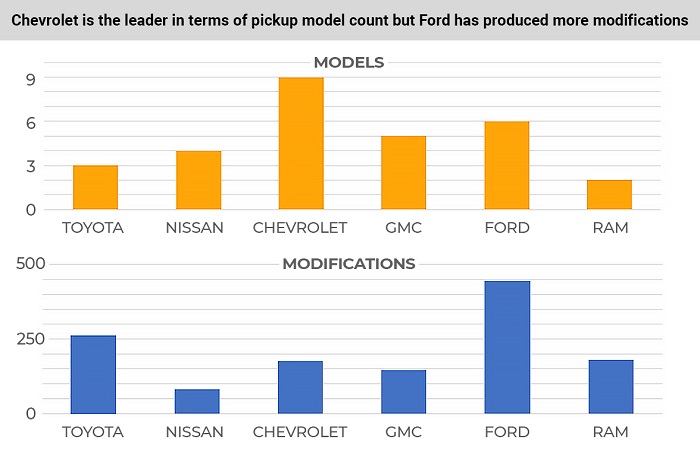
Ford has produced 26.4% of all modifications of pickups worldwide.
Five biggest producers in the niche have produced 72% of all pickup modifications worldwide.
We have to pay attention to Chevy truck stats, because Chevrolet has produced of 10% of pickup models worldwide.
We also analyzed the number of models and modifications on the pickup market and here's what we found:
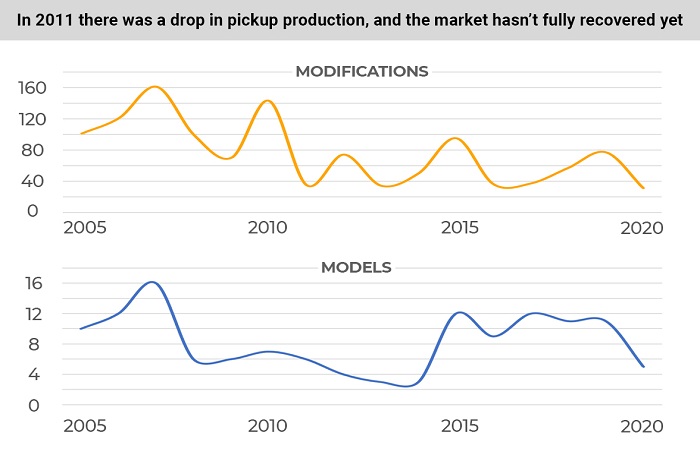
The graph shows that in the middle of the first decade of this century, pickup was quite a popular body type among manufacturers, but the crisis in the automotive sector in 2008 reduced their production, and the market recovered only in 2017, just to decline again in 2020, probably due to pandemics and economic downturns.
Over the past 5 years, manufacturers have been developing more modifications of the same model to meet the needs of the market. There were more than 13 modifications per model in 2018, in 2005 there were just a little more than 3 modifications per model on average.
Pickup truck statistics shows that the manufacturers are currently developing fewer models, but have increased the number of modifications with changes to the body, engines and other parameters.
Petrol engines make up 68.5% of the pickup market
There are five types of engines worldwide in terms of the type of fuel burned for pickups:
- Petrol - 66 models and 1155 modifications
- Diesel - 42 models and 510 modifications
- Petrol / ethanol - 2 models and 5 modifications
- Hybrid (petrol electricity) - 1 model and 12 modifications
- Electricity - 2 models and 4 modifications
68.5% of all pickups worldwide are petrol cars.
31.2% of pickups have diesel engines.
Out of the 100 oldest trucks, only 17% had diesel engines, and 83% had petrol engines.
Out of 100 newest trucks, 29% are diesel, 3% are EVs and 68% are petrol vehicles.
Despite the constant development of various alternative technologies, petrol pickups remain the most popular with manufacturers. Diesel pickup trucks have also increased their market share due to the good traction power of the engines and high torque.
Over 50 years, trucks have got 190% more powerful engines
The average power of pickups throughout the history is 260.3 hp.
On average, the first 100 modifications of the pickups had the power of 141 hp.
The 100 most recent pickup modifications showed an average power of 409 hp. Over 60 years of production, manufacturers have increased engine power by 190%.
The most powerful pickup in history is the Tesla Cybertruck TriMotor with an 800 hp engine.
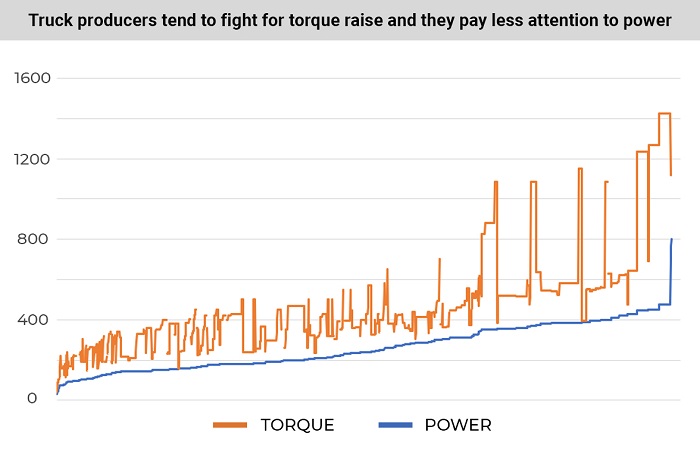
Of the pickups with internal combustion engines, the most powerful is the Ford F-450 Super Duty IV Crew Cab (2020), which received a 475 hp engine.
The least powerful pickup in history is the 1978 Citroen Acadiane with a 31 hp engine.
The average torque among all pickups in history is 479 Nm. The 2020 Ford F-450 has the highest torque at 1,424 Nm. The smallest torque car is the Citroen Acadiane 1978 with only 41 Nm.
Pickup manufacturers are gradually increasing engine power, but their main focus has been to increase engine torque. This specification gives the car good traction, provides cross-country ability and the ability to drive confidently with a loaded body.
Only 2.3% of pickups have front-wheel drive
If you look carefully at pickup rating, you'll see that the pickups have all types of drive - all-wheel, front and rear. Drive technologies are distributed as follows:
- Front-wheel drive - 11 models and 37 modifications
- Four-wheel drive - 69 models and 872 modifications
- Rear-wheel drive - 47 models and 746 modifications
Four-wheel drive turned out to be the most popular. 52.7% of all pickups are equipped with FWD. Also, 45% of cars have rear-wheel drive and only 2.3% have front-wheel drive.
The share of rear-wheel drive in the pickup market has remained virtually unchanged throughout history. Both among the oldest and the newest cars in this niche, almost half are cars with rear-wheel drive. Rear-wheel drive is convenient for manufacturers, as it allows to install paired wheels on the rear axle in some modifications, increasing the off-road capabilities of the vehicle and improving traction.
The average capacity of pickup engines exceeds 4000 cc
Pickups throughout history have a wide range of engine displacements - starting with 0.6 liters, or 602 cc, in the Citroen Acadiane to 8.1 liters (8128 cc) in the 2002 Chevrolet Avalanche.
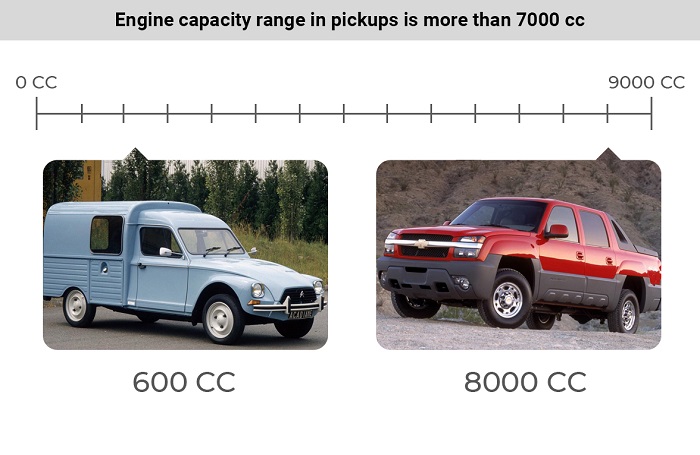
The average pickup engine displacement throughout history is 4.12 liters (4120 cc). The average engine capacity of pickups up to the year 2000 is 3.6 liters (3600 cc) with an average power of 165 hp, for cars from 2001 to 2021 it's 4.2 liters (4200 cc) with an average power of 285 hp.
Pickup manufacturers have increased engine displacement by 16.7% over first-generation vehicles, but power has also increased by 72.7%. Obviously, companies are using more modern technologies. However, pickup truck engine displacement remains 75.3% bigger than the passenger car market average (2.35L or 2350 cc).
Diesel pickups are one and a half times more economical than petrol ones
The average urban fuel consumption for all pickups is 18 mpg (13.9 liters per 100 km). The most economical pickup is the 2017 Renault Alaskan with a 2.3-liter diesel engine, its consumption in the city is 35 mpg (6.8 liters per 100 km). The least economical pickup is a 2005 Hummer H2 with a 6.0-liter petrol engine, the car shows a consumption of 8 mpg (30 liters per 100 km).
Average fuel consumption on the highway for pickups is at 22.6 mpg (10.4 liters per 100 km).

The average consumption of diesel pickups in the urban cycle is 24 mpg (10.2 liters per 100 km). For petrol cars, this figure is 16 mpg (14.5 liters per 100 km). The consumption of petrol pickups is on average 50% higher than of diesel vehicles.
The cars produced before 2005 showed an average urban consumption of 16 mpg (15.3 liters per 100 km). After 2005 and until today, the average consumption of pickups is 18 mpg (13.6 liters per 100 km).
We found that diesel pickups are one and a half times more economical than their petrol competitors. Over time, pickup truck consumption goes down as manufacturers offer more technologically advanced engines and consumers pay more attention to consumption figures in truck ratings.
More than 40% of pickups have 8-cylinder engines
On average, manufacturers install 4.1-liter engines in pickups. 21.4% of all pickups have engines over 5 liters, and 5.3% of cars have engines less than 2 liters.
The average number of cylinders in such a car is six. At the same time:
- 30% of cars have 4 cylinders;
- 3.9% have 5 cylinders;
- 25% have 6 cylinders;
- 40.8% have 8 cylinders.
One car from the list has a 2-cylinder engine. It is the 1978 Citroen Acadiane.
Manufacturers are gradually increasing the volume of engines in pickups, maintaining reliability and increasing the power of the engines. The most popular pickup engine in automotive history is the 8-cylinder engine.
The maximum speed of a pickup truck almost doesn't depend on its power
On average, the pickups have a top speed of 104 mph. The fastest pickup in the sample is the 1997 Holden UTE, which shows 136 mph.
On average, the pickup's acceleration is 12.3 seconds to 60 mph.

We analyzed the dependence of the maximum speed on the power of cars and saw that the maximum speed is almost independent of the engine power of the pickups.
Manufacturers prepare pickups for commercial and utility tasks, so speed and acceleration are not key factors for these vehicles. Engines aren't set for maximum output, but they are prepared for a long service life, good traction ability and moderate fuel consumption. That ensures good place for a car in pickup truck ratings.
All data for the research are placed in this PDF file.
Thank you for reading our research report. If you still have questions, additions and clarifications, write a comment under this publication.
About the authors
The CarAraC research team is composed of seasoned auto mechanics and automotive industry professionals, including individuals with advanced degrees and certifications in their field. Our team members boast prestigious credentials, reflecting their extensive knowledge and skills. These qualifications include: IMI: Institute of the Motor Industry, ASE-Certified Master Automobile Technicians; Coventry University, Graduate of MA in Automotive Journalism; Politecnico di Torino, Italy, MS Automotive Engineering; Ss. Cyril and Methodius University in Skopje, Mechanical University in Skopje; TOC Automotive College; DHA Suffa University, Department of Mechanical Engineering


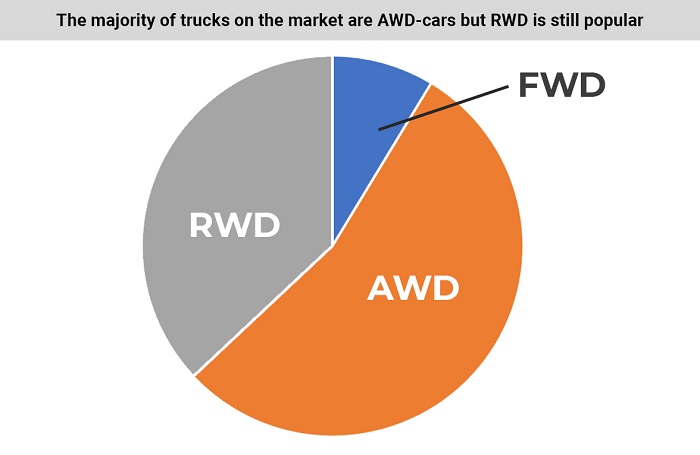
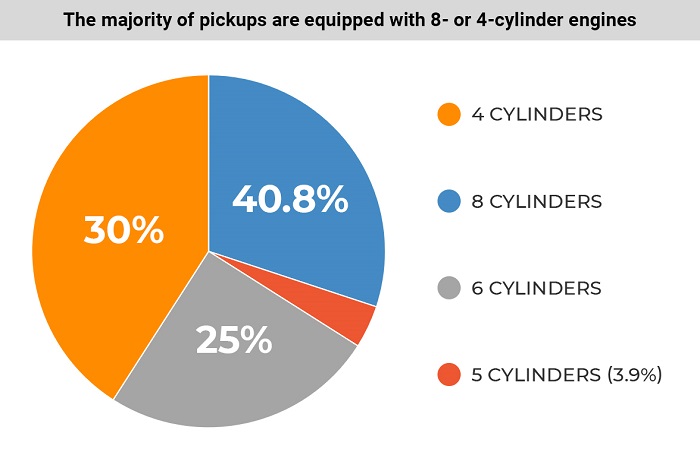
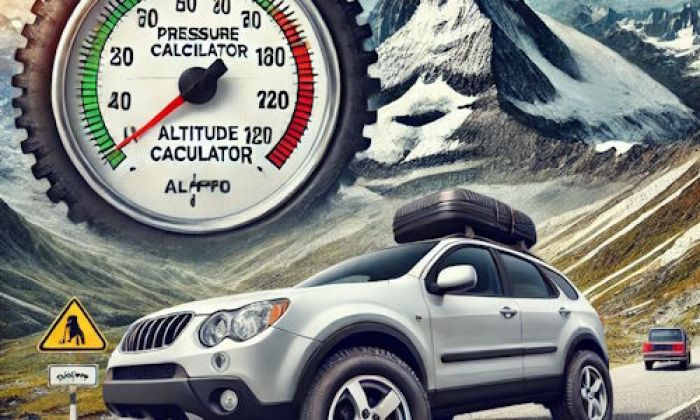




Add comment